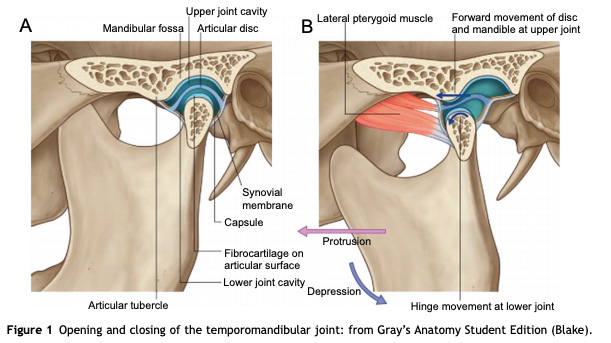The temporomandibular joint (TMJ) is the joint between the lower jaw, and the skull. It is the most superior joint in the body. The TMJ is akin to a ball and socket joint. However, there are three very unique points about the TMJ
Firstly, there is a fibrocartilaginous disc that sits between the mandibular condyle and the temporal bone. This acts as a shock absorber. The back part of this disc has nerve supply coming in from the trigeminal nerve, which is one of the largest cranial nerves in the head. So if the lower jaw is trapped in behind an underdeveloped upper jaw (which is quite common) then the nerve endings in the disc get compressed and result in excessive painful stimuli to the brain resulting in classic TMJ/TMD symptoms such as: headaches, migraines, brain fog
Secondly, the TMJ on one side cannot function independently and is always related to how the other TMJ functions. The both work together. So if one isn’t right, it affects the other.

Thirdly, the TMJ is the only joint in the body that has a hard end point, the teeth, that determine the position of the joint. It follows that if the teeth are not right, the TMJs are not happy!
When the lower jaw is positioned further back in the skull due to jaw underdevelopment, it can lead to compression of the articular disc that lies between the condyle and the mandibular fossa. With nerve endings embedded in the back part of this disc, compression can result in:
and many more other debilitating signs and symptoms.
Symptoms of TMJ disorder include:
TMD can be quite debilitating. And its quite serious too. Because the craniomandibular connection is a critical element of your health. It determines all descending signals from the brain to the rest of your body. It’s well known that lower jaw position affects cervical spine alignment. Anything we do in the mouth should ideally be checked with the cervical spine to ensure it is not disrupting balance. Here is how we do it at Sydney Airway Clinic.
It follows that if the lower jaw is not in an ideal position, then the cervical spine is misaligned and the brain’s descending nerve signals to the rest of the body are impinged…kind of link when the garden hose has a kink that affects water flow. And ofcourse, with cervical spine misalignment, neck posture is bound to suffer which filter’s it’s way down to all other postural centres of the body, including the spine, pelvis and feet!